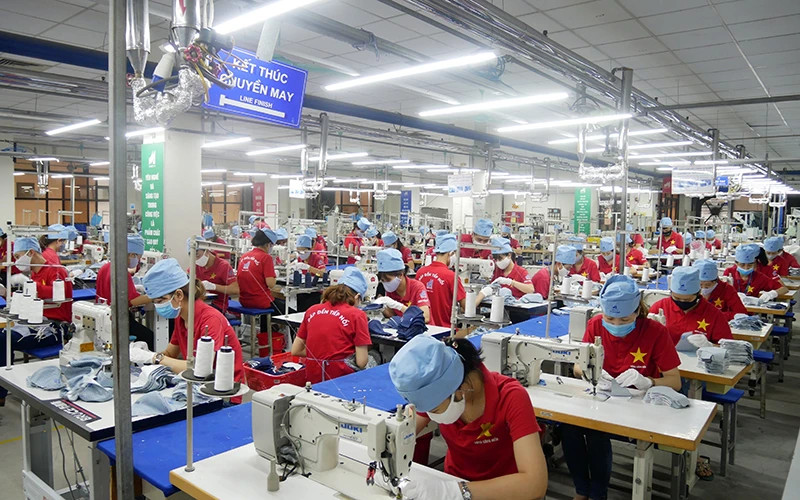To accomplish the set targets, businesses need to flexibly deploy appropriate solutions, contributing to promoting production and business activities. The number of orders is relatively abundant, but the unit price has not increased, even with contracts at a 30% to 50% reduction in price compared to 2023. Many textile and garment enterprises still accept these orders to ensure jobs for workers and maintain production.
Stabilising operations
General Director of Garment 10 Corporation (Garco 10) Than Duc Viet said the unit's total revenue in the first three months of the year reached 1.128 trillion VND, up 24.41% over the same period last year and reaching 25.07% of the 2024 plan. In particular, export revenue reached 1.020 trillion VND, and domestic revenue was more than 73.1 billion VND, an increase of 3% over the same period. The labour force has been maintained stable, with an average income of 10.7 million VND per person per month.
In the near future, Garco 10 will continue to focus investment on key projects, including the Thai Ha-Thai Binh Garment Factory and expanding production capacity at the Bim Son factory. It is forecasted that the unit will continue to face many difficulties as the market recovers slowly, with unpredictable developments. Although the orders have recovered, prices have not been improved. Even the prices of many product lines in the second half of the year are expected to be lower than the level of 2023. Meanwhile, requirements for production and delivery schedules are also gradually shortening. “To cope with difficulties, in the past two years, Garco 10 has been diversifying its products in both style and material. At the same time, the unit has combined AI and technology to maintain maximum efficiency”, Viet said.
Referring to the company’s production and business activities, the General Director of Dong Xuan Knitting Sole Member Company Limited, Nguyen Dang Loi, affirmed that in the first quarter of 2024, the business operated stably. Specifically, with orders related to textile and dyeing, this year’s capacity has increased to more than 100 tonnes per month, compared to the average of 60-70 tonnes in 2023. Garment orders have been signed until the end of September, and the company is negotiating for the fourth quarter of 2024.
Similarly, a leader from Thanh Cong Textile Garment - Investment – Trading Joint Stock Company said its revenue reached 39 million USD in the first three months of the year, a year-on-year increase of 6% and the highest level in the last six quarters, and its profit after tax was estimated to record an increase of 9%, to 2.5 million USD. In the first quarter of 2024, the company increased capacity to 100% and received 85% of orders for the second quarter and 80% for the third quarter. With this positive situation, the company expects to complete the set revenue target of 3.707 trillion VND.
According to the General Director of Vietnam National Textile and Garment Group (Vinatex) Cao Huu Hieu, in the past three months, the units under the Group have guaranteed jobs and kept the workforce stable. The total revenue reached 4.115 trillion VND, equal to 23%, with its profit reaching 96.8 billion VND, equal to 17% of the year's plan, and the average income reached 9.57 million VND per person per month, equivalent to 101% over the same period.
Appropriate roadmaps and directions
In the general context of many difficulties, the garment industry has shown signs of improvement in orders, but the efficiency has not been high because unit prices remain at a low level as in the third and fourth quarters of 2023. Meanwhile, cotton prices are expected to continue to be high due to speculation, hoarding, and difficulties in logistics. The export of yarn to the Chinese market is more difficult because the country is enhancing support policies in terms of taxes, fees, transportation, electricity prices, etc., for domestic production and consumption.
Vinatex General Director Cao Huu Hieu noted that to maintain stable production and business, textile and garment enterprises need to carry out solutions to ensure orders, quickly take advantage of all opportunities as well as continuously forecast and update the situation to make timely solutions, and drastically restructure units that have been facing long-term difficulties to improve productivity, lower costs, and apply advanced management solutions. In addition, the enterprises should promote the implementation of projects to increase production capacity, such as the fireproof fabric production project and the Nam Dinh fibre project.
Sharing the same opinion, Chairman of the Board of Directors of Vinatex Le Tien Truong stressed that in addition to difficulties and challenges, the textile and garment market still has room for the development of businesses with the right strategy, outstanding productivity and quality, and close supply chain links, meeting new requirements of the digital economy and green economy with appropriate steps. In the first quarter of 2024, the production and business efficiency of many companies improved over the same period, especially large ones in the garment industry, recording an improvement of over 20%.
In the coming time, the group's executive agency will closely follow market information and production and business activities of affiliated units to make flexible and breakthrough solutions in developing their products and seeking new markets to bring better efficiency.
Analysing more clearly the difficulties of the business, the Chairman of the Board of Directors of Hung Yen Garment Corporation (Hugaco), Nguyen Xuan Duong, said that although the number of orders is relatively large, the prices are low, while costs are all increasing, such as wages, prices of input materials, etc. On the other hand, workers tend to move to newly opened markets such as the Republic of Korea (RoK) and Japan to improve their lives, which is also a factor influencing the maintenance of stable production and business.
“There are also other pressures due to the increased costs of many orders in Vietnam, so large foreign businesses tend to downsise and move to other countries. Moreover, some major markets added more inventory, and total demand has not increased and is even predicted to decrease by 5% to 10% compared to 2023. Not to mention, a series of large fashion businesses in the world are facing the risk of bankruptcy, causing many domestic businesses to be unable to recover tens of millions of dollars in wages”, Duong added.
He also noted that while order prices are low and the wages for workers have not been improved, the businesses have been "constrained" by the regulations that workers are not allowed to work overtime. Their working hours are expected to be reduced to 40 hours per week, which will cause more difficulties for workers.
While in Japan or some other markets, workers can work between 10 to 12 hours per day. “Even workers in the industry want to work more to save money, so it is necessary to promulgate policies that suit the real conditions and needs of workers. In addition, relevant functional agencies need to have support mechanisms and policies in terms of capital to help businesses, especially small and medium-sized enterprises, to promote investment and develop production”, Nguyen Xuan Duong affirmed.
In the first quarter of 2024, textile and garment export turnover reached nearly 10 billion USD, up nearly 10% over the same period. This is the motivation for businesses in the industry to complete their target. In addition, the business has been investing in modern equipment, improving management, etc., to increase competitiveness and meet the increasing demands of the market.
Vu Duc Giang, Chairman of Vietnam Textile and Apparel Association
















